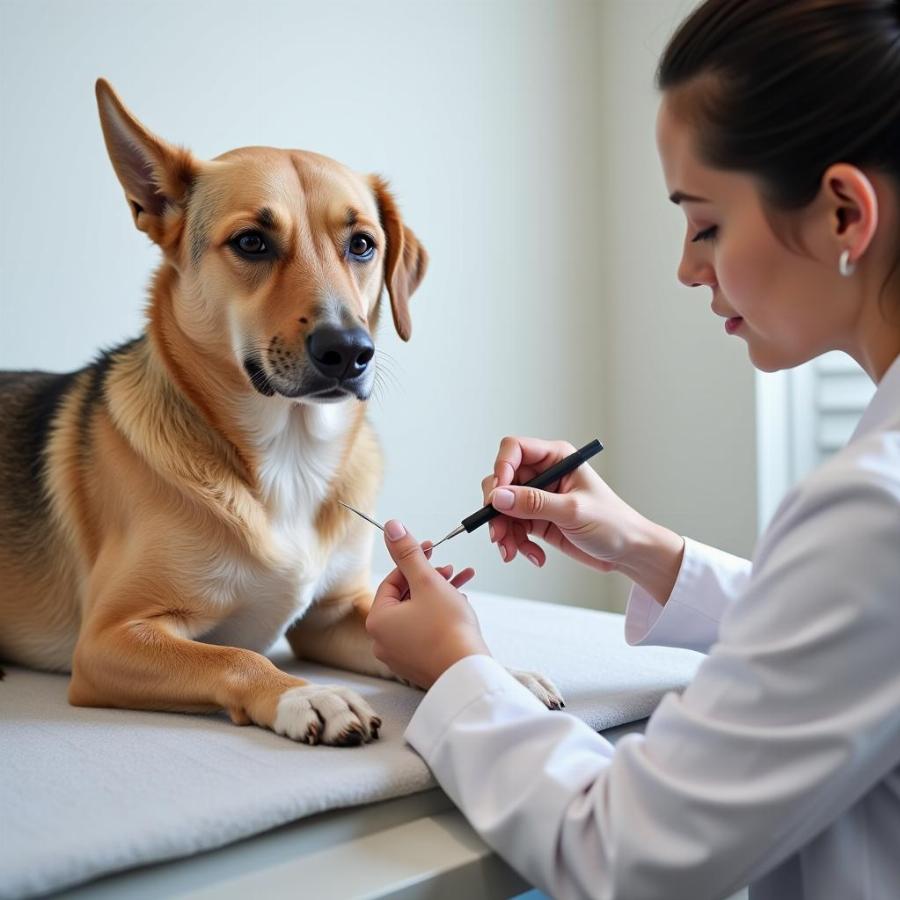Subcutaneous mast cell tumors (MCTs) are a common type of skin cancer found in dogs. Understanding what they are, how they are diagnosed, and the treatment options available can empower you to make the best decisions for your furry friend. This article delves into the essential information you need about subcutaneous mast cell tumors in dogs, from initial diagnosis to long-term care.
What are Subcutaneous Mast Cell Tumors in Dogs?
Mast cells are a part of the immune system and are normally present throughout the body, including the skin. A subcutaneous mast cell tumor occurs when these cells grow uncontrollably beneath the skin. While some MCTs are benign, others are malignant and can spread to other parts of the body, including lymph nodes, the liver, and the spleen. The term “subcutaneous” specifically refers to the location of the tumor, which is under the skin, often appearing as a lump or bump. Early detection and treatment are crucial in managing this type of cancer.
Diagnosing Subcutaneous Mast Cell Tumors
Diagnosing a subcutaneous mast cell tumor typically involves a few key steps. Your veterinarian will start with a physical examination, feeling the lump and assessing its characteristics. A fine-needle aspiration (FNA) is often the next step, where a small needle is inserted into the tumor to collect cells for microscopic examination. This is a relatively quick and painless procedure that can often provide a preliminary diagnosis. For a more definitive diagnosis and to determine the grade of the tumor (how aggressive it is), a biopsy may be necessary. This involves removing a small piece of tissue for further analysis.
What should you look for? Be observant of any new lumps or bumps on your dog’s skin. Pay attention to any changes in existing lumps, such as rapid growth, changes in color, or ulceration. While not all lumps are cancerous, it’s crucial to have any unusual growths checked by your veterinarian.
Treatment Options for Subcutaneous Mast Cell Tumors
Treatment options for subcutaneous mast cell tumors vary depending on several factors, including the grade of the tumor, its location, and the overall health of your dog. Surgical removal is the most common treatment, especially for lower-grade tumors. Radiation therapy may be recommended in cases where complete surgical removal is difficult or impossible. Chemotherapy is sometimes used for more aggressive tumors or those that have spread to other parts of the body. In some cases, a combination of these therapies may be used.
 Subcutaneous Mast Cell Tumor Diagnosis in Dogs
Subcutaneous Mast Cell Tumor Diagnosis in Dogs
Grading and Staging of MCTs
Grading and staging are important processes that help determine the prognosis and guide treatment decisions. Grading assesses the aggressiveness of the tumor cells under a microscope. Lower-grade tumors are typically less aggressive, while higher-grade tumors are more likely to spread. Staging involves determining the extent of the cancer, including whether it has spread to lymph nodes or other organs.
How can I help my dog after surgery? Post-operative care typically involves keeping the surgical site clean and dry, administering any prescribed medications, and monitoring for any signs of infection or complications. Your veterinarian will provide specific instructions based on your dog’s individual needs.
Living with a Dog with a Subcutaneous Mast Cell Tumor
Living with a dog diagnosed with a subcutaneous mast cell tumor can be challenging, but with proper care and monitoring, many dogs can live happy and fulfilling lives. Regular check-ups with your veterinarian are essential to monitor for any recurrence or progression of the disease. Be prepared for potential side effects from treatment, such as nausea, vomiting, or loss of appetite.
Are Certain Breeds Predisposed to MCTs?
While any dog can develop a subcutaneous mast cell tumor, certain breeds are considered to be at higher risk, including Boxers, Boston Terriers, Golden Retrievers, Labrador Retrievers, and Pugs. If you own one of these breeds, regular veterinary check-ups and being aware of any unusual skin changes are particularly important.
What are the long-term effects of MCTs? The long-term effects of MCTs can vary depending on the individual dog and the characteristics of the tumor. Some dogs experience complete remission after treatment, while others may require ongoing management. Regular monitoring and follow-up care are crucial for detecting and addressing any potential complications.
Conclusion
Subcutaneous mast cell tumors are a common concern for dog owners. Early detection, accurate diagnosis, and appropriate treatment are key to managing this type of cancer. By being informed and proactive, you can provide the best possible care for your furry companion and help them live a happy and healthy life, even with a subcutaneous mast cell tumor diagnosis.
FAQ
-
What are the symptoms of a subcutaneous mast cell tumor in dogs? The most common symptom is a lump or bump under the skin, which may or may not be itchy or painful.
-
Are all mast cell tumors cancerous? No, some mast cell tumors are benign, but it’s essential to have any lump checked by a veterinarian to determine its nature.
-
How is a subcutaneous mast cell tumor diagnosed? Diagnosis typically involves a physical exam, fine-needle aspiration, and potentially a biopsy.
-
What are the treatment options for MCTs? Treatment options include surgery, radiation therapy, and chemotherapy, depending on the specific case.
-
What is the prognosis for a dog with a subcutaneous mast cell tumor? The prognosis varies depending on several factors, including the grade of the tumor, its location, and the dog’s overall health.